The chemical filling system market is forecast to expand from USD 4,739.6 million in 2025 to USD 7,868.7 million in 2035 at a CAGR of 5.2%. End-use industry dynamics highlight how construction, packaging, automotive, renewable energy, and healthcare applications shape demand for precision filling technologies. Growth in infrastructure investment and construction activity creates strong consumption for sealants, adhesives, and coatings that require high-accuracy filling systems. Increased cement additives, waterproofing solutions, and specialty chemicals for flooring and insulation also expand the need for automated filling lines that can handle corrosive or viscous formulations. This construction-driven trend ensures consistent procurement of both large-scale industrial filling machines and portable units suitable for on-site packaging.
Packaging regulations are a structural factor influencing demand. Regulations for chemical packaging, labeling, and safety compliance mandate precision filling to avoid spillage, overfilling, or contamination. Pharmaceutical packaging laws drive demand for sterile filling equipment capable of operating in cleanroom conditions, while agrochemical regulations enforce accuracy for pesticides and fertilizers. Food-grade compliance creates another layer of demand as certain chemical fillers are adapted to process additives, preservatives, and nutritional ingredients. The regulatory environment drives both replacement demand and investment in advanced systems with integrated monitoring and data logging capabilities.
The expansion of electric vehicles and battery technologies is reshaping demand patterns. Chemical fillers are used extensively in electrolyte solutions, battery coatings, and thermal management fluids. Automotive manufacturers are investing in high-precision systems capable of handling flammable or corrosive chemistries safely. Demand is reinforced by the adoption of lightweight composites, adhesives, and lubricants that require controlled dosing. EV penetration enhances long-term demand stability as production volumes rise across North America, Europe, and Asia Pacific.
Adjacent industries are also shaping adoption cycles. Renewable energy applications such as solar panel coatings and wind turbine lubricants contribute to greater consumption of specialty fillers. Healthcare is becoming an emerging segment as biopharmaceutical manufacturing and diagnostics require sterile and contamination-free filling systems. Diagnostic reagents, vaccines, and bioculture media are processed using high-precision filling platforms that ensure compliance with stringent health standards. The convergence of healthcare and chemical processing technologies is expanding end-use diversity for manufacturers of filling systems.
Long-term structural drivers are defined by automation and digitalization of chemical packaging. Industries with cyclical consumption patterns, such as automotive or agriculture, generate demand fluctuations, while structural adoption in pharmaceuticals, construction, and regulated packaging guarantees steady base demand. At 5.2% CAGR, the chemical filling system market demonstrates resilience shaped by evolving compliance standards, new material consumption trends, and cross-industry interdependencies. Demand growth is diversified, ensuring balanced opportunities across construction, automotive, renewable energy, healthcare, and packaging end uses through 2035.
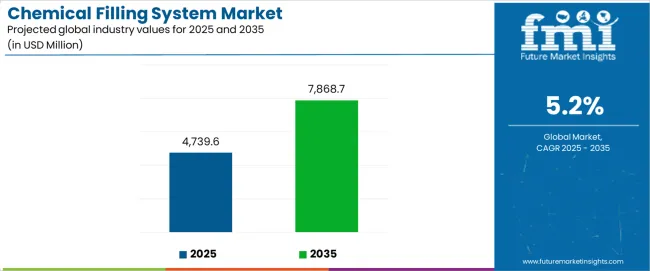
| Period | Primary Revenue Buckets | Share | Notes |
|---|---|---|---|
| Today | Fully-automatic filling systems | 62% | Advanced automation, established manufacturers |
| Semi-automatic filling systems | 28% | Cost-effective solutions, medium-scale operations | |
| Manual and basic systems | 10% | Traditional applications, small-scale facilities | |
| Future (3-5 yrs) | Advanced fully-automatic systems | 55-58% | ai integration, predictive maintenance |
| Pharmaceutical applications | 18-22% | Precision filling, sterile environments | |
| Chemical and petrochemical | 15-18% | High-volume processing, safety features | |
| Agriculture and agrochemicals | 8-12% | Specialized handling, environmental compliance | |
| Daily chemicals and personal care | 4-8% | Consumer products, flexible packaging | |
| Smart and IoT-enabled systems | 6-10% | Connected manufacturing, data analytics |
| Metric | Value |
|---|---|
| Market Value (2025) | USD 4,739.6 million |
| Market Forecast (2035) | USD 7,868.7 million |
| Growth Rate | 5.2% CAGR |
| Leading Automation Type | Fully-Automatic Systems |
| Primary Application | Chemical & Petrochemical Segment |
The chemical filling system market demonstrates strong fundamentals with fully-automatic filling systems capturing a dominant share through advanced automation properties and industrial application optimization. Chemical and petrochemical applications drive primary demand, supported by increasing safety requirements and manufacturing industry modernization initiatives. Geographic expansion remains concentrated in developed markets with established industrial infrastructure, while emerging economies show accelerating adoption rates driven by manufacturing industry modernization initiatives and rising automation standards.
Design for operational precision, not just throughput
Primary Classification: The chemical filling system market segments by automation type into fully-automatic, semi-automatic, and manual systems, representing the evolution from traditional manual operations to sophisticated automated solutions for comprehensive chemical filling optimization.
Secondary Classification: Application segmentation divides the chemical filling system market into chemical and petrochemical, pharmaceutical, agriculture and agrochemicals, daily chemicals and personal care, and others, reflecting distinct requirements for filling precision, safety standards, and process control specifications.
Tertiary Classification: End-use segmentation covers chemical manufacturers, pharmaceutical companies, agrochemical producers, personal care manufacturers, and contract packaging services, while distribution channels span direct sales, equipment distributors, and specialized industrial suppliers.
Regional Classification: Geographic distribution covers North America, Latin America, Western Europe, Eastern Europe, East Asia, South Asia Pacific, and Middle East & Africa, with developed markets leading adoption while emerging economies show accelerating growth patterns driven by industrial modernization programs.
The segmentation structure reveals automation progression from traditional manual systems toward sophisticated fully-automatic solutions with enhanced precision capabilities, while application diversity spans from pharmaceutical facilities to chemical processing requiring specialized filling solutions.
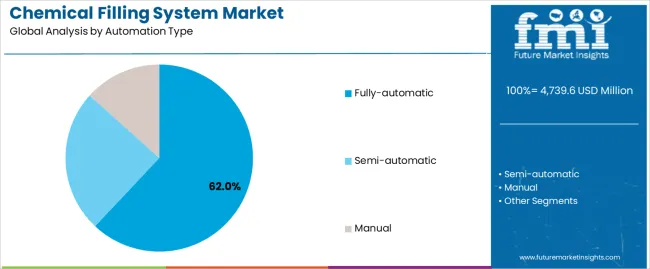
Market Position: Fully-automatic filling systems command the leading position in the chemical filling system market with 62% market share through proven automation technologies, including precision control, safety integration, and operational optimization that enable manufacturing operators to achieve optimal production efficiency across diverse chemical and pharmaceutical environments.
Value Drivers: The segment benefits from manufacturing industry preference for automated systems that provide enhanced precision, operational safety, and production efficiency without requiring manual intervention infrastructure. Advanced automation features enable enhanced process control, safety monitoring, and integration with existing manufacturing systems, where precision performance and operational reliability represent critical production requirements.
Competitive Advantages: Fully-automatic filling systems differentiate through proven reliability effectiveness, advanced automation characteristics, and integration with established production management systems that enhance facility productivity while maintaining optimal safety standards suitable for diverse chemical applications.
Key market characteristics:
Semi-automatic filling systems maintain a 28% market position in the chemical filling system market due to their cost-effectiveness and operational flexibility benefits. These systems appeal to facilities requiring efficient filling solutions with moderate automation levels for medium-scale operations. Market growth is driven by manufacturing expansion, emphasizing cost-effective automation solutions and operational efficiency through optimized control designs.
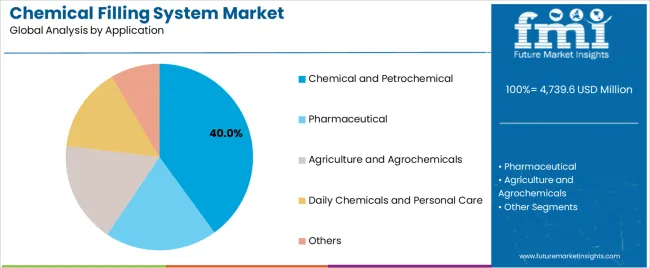
Market Context: Chemical and petrochemical applications demonstrate strong growth in the chemical filling system market with 40% market share due to widespread adoption of automated filling systems and increasing focus on manufacturing excellence, operational safety, and production efficiency applications that maximize filling effectiveness while maintaining industrial standards.
Appeal Factors: Chemical operators prioritize system reliability, safety compliance, and integration with existing process infrastructure that enables coordinated filling operations across multiple production lines. The segment benefits from substantial chemical industry investment and modernization programs that emphasize the acquisition of advanced filling systems for production optimization and safety applications.
Growth Drivers: Chemical expansion programs incorporate filling systems as essential components for production operations, while industrial growth increases demand for filling capabilities that comply with safety standards and minimize operational complexity.
Market Challenges: Varying chemical properties and production scale complexity may limit system standardization across different facilities or processing scenarios.
Application dynamics include:
Pharmaceutical applications capture 22% market share through specialized precision requirements in drug manufacturing facilities, sterile environments, and pharmaceutical applications. These facilities demand advanced filling systems capable of supporting regulatory compliance while providing precision filling access and contamination control capabilities.
Agriculture and agrochemicals applications account for 18% market share, including pesticide production, fertilizer manufacturing, and agricultural operations requiring specialized filling capabilities for chemical handling optimization and environmental compliance.
Market Context: Chemical Manufacturers dominate the chemical filling system market with a 6.0% CAGR, reflecting the primary demand source for chemical filling system technology in production applications and process standardization.
Business Model Advantages: Chemical Manufacturers provide direct market demand for standardized filling systems, driving volume production and cost optimization while maintaining quality control and safety requirements.
Operational Benefits: Chemical Manufacturer applications include process standardization, safety assurance, and quality control that drive consistent demand for filling systems while providing access to latest automation technologies.
| Category | Factor | Impact | Why It Matters |
|---|---|---|---|
| Driver | Industrial automation growth & manufacturing modernization (Industry 4.0, smart factories) | ★★★★★ | Growing manufacturing sector requires automated filling systems with enhanced precision capabilities and safety properties proven effective across industrial applications. |
| Driver | Safety regulations advancement & chemical handling requirements (OSHA compliance, hazmat standards) | ★★★★★ | Transforms filling requirements from "basic equipment" to "safety-critical systems"; operators that offer compliant systems and safety features gain competitive advantage. |
| Driver | Pharmaceutical market growth & precision requirements (sterile filling, regulatory compliance) | ★★★★☆ | Pharmaceutical facilities need precise, contamination-free filling; demand for specialized and superior filling solutions expanding addressable market. |
| Restraint | High capital costs & equipment investment barriers (especially for small manufacturers) | ★★★★☆ | Smaller manufacturing operators defer automation upgrades; increases price sensitivity and slows advanced filling system adoption in cost-conscious markets. |
| Restraint | Technical complexity & maintenance requirements (specialized expertise, downtime risks) | ★★★☆☆ | Complex automated systems require skilled maintenance and operational expertise, potentially limiting adoption in facilities lacking technical capabilities. |
| Trend | IoT integration & predictive maintenance (remote monitoring, data analytics) | ★★★★★ | Connected filling systems, performance optimization, and predictive analytics transform operations; technology integration and data-driven maintenance become core value propositions. |
| Trend | Customization & application-specific solutions (chemical compatibility, specialized handling) | ★★★★☆ | Custom filling systems for specific applications and chemicals; specialized designs and targeted handling capabilities drive competition toward customization solutions. |
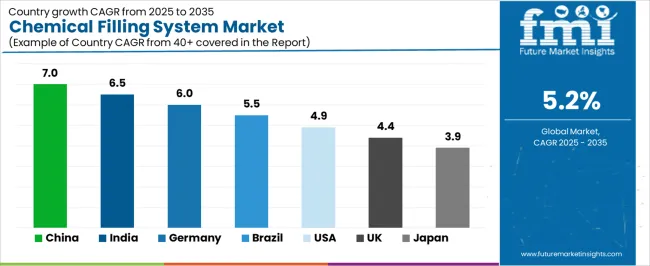
The chemical filling system market demonstrates varied regional dynamics with Growth Leaders including China (7.0% growth rate) and India (6.5% growth rate) driving expansion through industrial development initiatives and manufacturing modernization. Steady Performers encompass Germany (6.0% growth rate), Brazil (5.5% growth rate), and developed regions, benefiting from established manufacturing industries and automation adoption. Mature Markets feature United States (4.9% growth rate), United Kingdom (4.4% growth rate), and Japan (3.9% growth rate), where manufacturing advancement and automation standardization requirements support consistent growth patterns.
Regional synthesis reveals East Asian markets leading adoption through industrial expansion and manufacturing development, while North American countries maintain steady expansion supported by automation technology advancement and safety standardization requirements. European markets show strong growth driven by industrial applications and precision integration trends.
| Region/Country | 2025-2035 Growth | How to win | What to watch out |
|---|---|---|---|
| China | 7.0% | Focus on high-volume manufacturing solutions | Regulatory changes; local competition |
| India | 6.5% | Lead with cost-effective automation systems | Import restrictions; technical barriers |
| Germany | 6.0% | Provide precision engineering solutions | Over-regulation; lengthy approvals |
| Brazil | 5.5% | Offer value-oriented manufacturing systems | Currency fluctuations; import duties |
| United States | 4.9% | Push automation integration | Compliance costs; scaling challenges |
| United Kingdom | 4.4% | Focus on pharmaceutical applications | Economic impacts; equipment costs |
| Japan | 3.9% | Emphasize precision manufacturing | Traditional preferences; adoption rates |
China establishes fastest market growth through aggressive industrial development programs and comprehensive manufacturing expansion, integrating advanced chemical filling systems as standard components in manufacturing facilities and chemical installations. The country's 7.0% growth rate reflects government initiatives promoting industrial infrastructure and domestic automation capabilities that mandate the use of automated filling systems in chemical and pharmaceutical facilities. Growth concentrates in major industrial hubs, including Shanghai, Guangzhou, and Tianjin, where manufacturing development showcases integrated filling systems that appeal to chemical operators seeking production optimization capabilities and operational applications.
Chinese manufacturers are developing cost-effective filling solutions that combine domestic production advantages with advanced automation features, including enhanced precision control and improved safety capabilities. Distribution channels through industrial suppliers and equipment distributors expand market access, while government support for manufacturing development supports adoption across diverse chemical and pharmaceutical segments.
Strategic Market Indicators:
In Mumbai, Delhi, and Chennai, manufacturing facilities and chemical operators are implementing automated chemical filling systems as standard equipment for production optimization and safety applications, driven by increasing government industrial investment and manufacturing modernization programs that emphasize the importance of automation capabilities. The chemical filling system market holds a 6.5% growth rate, supported by government industrial initiatives and manufacturing development programs that promote automated filling systems for chemical and pharmaceutical facilities. Indian operators are adopting filling systems that provide consistent production efficiency and safety features, particularly appealing in industrial regions where automation and operational excellence represent critical business requirements.
Market expansion benefits from growing manufacturing capabilities and international technology partnerships that enable domestic production of automated filling systems for chemical and pharmaceutical applications. Technology adoption follows patterns established in industrial equipment, where reliability and precision drive procurement decisions and operational deployment.
Market Intelligence Brief:
Germany's advanced manufacturing market demonstrates sophisticated chemical filling system deployment with documented precision effectiveness in industrial applications and manufacturing facilities through integration with existing process systems and operational infrastructure. The country leverages engineering expertise in automation and precision systems integration to maintain a 6.0% growth rate. Industrial centers, including North Rhine-Westphalia, Bavaria, and Baden-Württemberg, showcase premium installations where filling systems integrate with comprehensive manufacturing platforms and facility management systems to optimize production precision and operational effectiveness.
German manufacturers prioritize system quality and EU compliance in filling system development, creating demand for premium systems with advanced features, including facility integration and precision control systems. The chemical filling system market benefits from established industrial infrastructure and a willingness to invest in automated filling technologies that provide long-term operational benefits and compliance with international safety standards.
Market Intelligence Brief:
Brazil's market expansion benefits from diverse industrial demand, including manufacturing modernization in São Paulo and Rio de Janeiro, chemical facility upgrades, and government industrial programs that increasingly incorporate automated filling solutions for production applications. The country maintains a 5.5% growth rate, driven by rising manufacturing activity and increasing recognition of automation benefits, including precise production control and enhanced operational effectiveness.
Market dynamics focus on cost-effective filling solutions that balance production performance with affordability considerations important to Brazilian manufacturing operators. Growing industrial development creates continued demand for modern filling systems in new manufacturing infrastructure and facility modernization projects.
Strategic Market Considerations:
United States establishes market leadership through comprehensive industrial programs and advanced manufacturing infrastructure development, integrating chemical filling systems across pharmaceutical and chemical applications. The country's 4.9% growth rate reflects established manufacturing industry relationships and mature automation technology adoption that supports widespread use of automated filling systems in chemical and pharmaceutical facilities. Growth concentrates in major industrial centers, including Texas, California, and Illinois, where filling technology showcases mature deployment that appeals to manufacturers seeking proven precision capabilities and operational efficiency applications.
American manufacturing providers leverage established distribution networks and comprehensive technical support capabilities, including installation programs and training support that create customer relationships and operational advantages. The chemical filling system market benefits from mature regulatory standards and safety requirements that mandate filling system use while supporting technology advancement and operational optimization.
Market Intelligence Brief:
United Kingdom's manufacturing market demonstrates integrated chemical filling system deployment with documented precision effectiveness in pharmaceutical applications and chemical facilities through integration with existing process systems and operational infrastructure. The country maintains a 4.4% growth rate, supported by manufacturing excellence programs and precision effectiveness requirements that promote automated filling systems for industrial applications. Manufacturing facilities across England, Scotland, and Wales showcase systematic installations where filling systems integrate with comprehensive production platforms to optimize operational precision and manufacturing outcomes.
UK manufacturing providers prioritize system reliability and industry compatibility in filling system procurement, creating demand for validated systems with proven precision features, including quality monitoring integration and process control systems. The chemical filling system market benefits from established industrial infrastructure and excellence requirements that support filling technology adoption and operational effectiveness.
Market Intelligence Brief:
Japan's market growth benefits from precision manufacturing demand, including advanced industrial facilities in Tokyo and Osaka, quality integration, and automation enhancement programs that increasingly incorporate filling solutions for production applications. The country maintains a 3.9% growth rate, driven by manufacturing technology advancement and increasing recognition of precision automation benefits, including accurate production control and enhanced manufacturing outcomes.
Market dynamics focus on high-precision filling solutions that meet Japanese quality standards and manufacturing effectiveness requirements important to industrial operators. Advanced manufacturing technology adoption creates continued demand for sophisticated filling systems in industrial facility infrastructure and production modernization projects.
Strategic Market Considerations:
The European chemical filling system market is projected to grow from USD 1,047.8 million in 2025 to USD 1,743.2 million by 2035, registering a CAGR of 5.3% over the forecast period. Germany is expected to maintain its leadership position with a 36.4% market share in 2025, supported by its advanced manufacturing infrastructure and major industrial centers.
United Kingdom follows with a 23.1% share in 2025, driven by comprehensive pharmaceutical programs and precision manufacturing development initiatives. France holds a 17.2% share through specialized chemical applications and industrial compliance requirements. Italy commands a 13.8% share, while Spain accounts for 5.9% in 2025. The rest of Europe region is anticipated to gain momentum, expanding its collective share from 3.6% to 4.1% by 2035, attributed to increasing industrial adoption in Nordic countries and emerging manufacturing facilities implementing automation modernization programs.
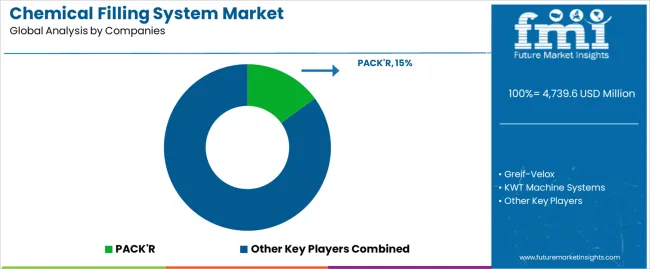
| Stakeholder | What they actually control | Typical strengths | Typical blind spots |
|---|---|---|---|
| Global technology leaders | R&D capabilities, automation patents, global service networks | Advanced automation, proven reliability, worldwide support | Product refresh cycles; regional customization needs |
| Automation specialists | Control system integration; advanced automation technologies; precision capabilities | Latest automation first; attractive ROI on productivity effectiveness | Service density outside core regions; scaling complexity |
| Regional equipment providers | Local compliance, fast delivery, nearby customer support | "Close to customer" support; pragmatic pricing; local regulations | Technology gaps; talent retention in engineering |
| Full-service integrators | Complete solutions, installation services, maintenance programs | Lowest operational risk; comprehensive support | Service costs if overpromised; technology obsolescence |
| Application specialists | Specialized industries, custom solutions, niche applications | Win specialized applications; flexible configurations | Scalability limitations; narrow market focus |
| Item | Value |
|---|---|
| Quantitative Units | USD 4,739.6 million |
| Automation Type | Fully-automatic, Semi-automatic, Manual |
| Application | Chemical and Petrochemical, Pharmaceutical, Agriculture and Agrochemicals, Daily Chemicals and Personal Care, Others |
| End Use | Chemical Manufacturers, Pharmaceutical Companies, Agrochemical Producers, Personal Care Manufacturers, Contract Packaging Services |
| Regions Covered | North America, Latin America, Western Europe, Eastern Europe, East Asia, South Asia Pacific, Middle East & Africa |
| Countries Covered | China, India, Germany, Brazil, United States, United Kingdom, Japan, Canada, France, Australia, and 25+ additional countries |
| Key Companies Profiled | PACK'R, Greif-Velox, KWT Machine Systems, DTM Packaging, IC Filling Systems, CDA, Shibuya Kogyo, Tenco Specialty Equipment |
| Additional Attributes | Dollar sales by automation type and application categories, regional adoption trends across East Asia, North America, and Western Europe, competitive landscape with equipment manufacturers and system integrators, manufacturing operator preferences for filling effectiveness and precision control, integration with industrial platforms and process management systems, innovations in automation technology and filling enhancement, and development of advanced filling solutions with enhanced precision and operational optimization capabilities. |
The global chemical filling system market is estimated to be valued at USD 4,739.6 million in 2025.
The market size for the chemical filling system market is projected to reach USD 7,868.7 million by 2035.
The chemical filling system market is expected to grow at a 5.2% CAGR between 2025 and 2035.
The key product types in chemical filling system market are fully-automatic, semi-automatic and manual.
In terms of application, chemical and petrochemical segment to command 40.0% share in the chemical filling system market in 2025.






Our Research Products

The "Full Research Suite" delivers actionable market intel, deep dives on markets or technologies, so clients act faster, cut risk, and unlock growth.

The Leaderboard benchmarks and ranks top vendors, classifying them as Established Leaders, Leading Challengers, or Disruptors & Challengers.

Locates where complements amplify value and substitutes erode it, forecasting net impact by horizon

We deliver granular, decision-grade intel: market sizing, 5-year forecasts, pricing, adoption, usage, revenue, and operational KPIs—plus competitor tracking, regulation, and value chains—across 60 countries broadly.

Spot the shifts before they hit your P&L. We track inflection points, adoption curves, pricing moves, and ecosystem plays to show where demand is heading, why it is changing, and what to do next across high-growth markets and disruptive tech

Real-time reads of user behavior. We track shifting priorities, perceptions of today’s and next-gen services, and provider experience, then pace how fast tech moves from trial to adoption, blending buyer, consumer, and channel inputs with social signals (#WhySwitch, #UX).

Partner with our analyst team to build a custom report designed around your business priorities. From analysing market trends to assessing competitors or crafting bespoke datasets, we tailor insights to your needs.
Supplier Intelligence
Discovery & Profiling
Capacity & Footprint
Performance & Risk
Compliance & Governance
Commercial Readiness
Who Supplies Whom
Scorecards & Shortlists
Playbooks & Docs
Category Intelligence
Definition & Scope
Demand & Use Cases
Cost Drivers
Market Structure
Supply Chain Map
Trade & Policy
Operating Norms
Deliverables
Buyer Intelligence
Account Basics
Spend & Scope
Procurement Model
Vendor Requirements
Terms & Policies
Entry Strategy
Pain Points & Triggers
Outputs
Pricing Analysis
Benchmarks
Trends
Should-Cost
Indexation
Landed Cost
Commercial Terms
Deliverables
Brand Analysis
Positioning & Value Prop
Share & Presence
Customer Evidence
Go-to-Market
Digital & Reputation
Compliance & Trust
KPIs & Gaps
Outputs
Full Research Suite comprises of:
Market outlook & trends analysis
Interviews & case studies
Strategic recommendations
Vendor profiles & capabilities analysis
5-year forecasts
8 regions and 60+ country-level data splits
Market segment data splits
12 months of continuous data updates
DELIVERED AS:
PDF EXCEL ONLINE
Chemical Imaging Systems Market
Filling and Dispensing System for Nuclear Medicine Market Size and Share Forecast Outlook 2025 to 2035
Reagent Filling Systems Market Analysis – Growth & Forecast 2024-2034
Seasoning Filling System Market Size and Share Forecast Outlook 2025 to 2035
Bioelectrochemical Systems For Wastewater Treatment Market Size and Share Forecast Outlook 2025 to 2035
Digital Liquid Filling Systems Market Size and Share Forecast Outlook 2025 to 2035
Demand for Seasoning Filling System in USA Size and Share Forecast Outlook 2025 to 2035
Personal Care Products Filling System Market Size and Share Forecast Outlook 2025 to 2035
Chemical Hydraulic Valves Market Size and Share Forecast Outlook 2025 to 2035
Chemical Vapor Deposition Market Forecast Outlook 2025 to 2035
Chemical Recycling Service Market Forecast Outlook 2025 to 2035
Chemical Dosing Equipment Market Size and Share Forecast Outlook 2025 to 2035
Chemical Absorbent Pads Market Size and Share Forecast Outlook 2025 to 2035
Chemical Indicator Inks Market Size and Share Forecast Outlook 2025 to 2035
Filling and Sealing Machine Market Size and Share Forecast Outlook 2025 to 2035
Chemical Boiler Market Size and Share Forecast Outlook 2025 to 2035
Chemical Hardener Compounds Market Size and Share Forecast Outlook 2025 to 2035
Chemical Anchors Market Size and Share Forecast Outlook 2025 to 2035
Chemical Peel Market Size and Share Forecast Outlook 2025 to 2035
Chemical Protective Gloves Market Size and Share Forecast Outlook 2025 to 2035

Thank you!
You will receive an email from our Business Development Manager. Please be sure to check your SPAM/JUNK folder too.
Chat With
MaRIA